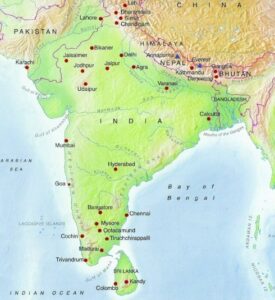Roadmap for Answer Writing 1. Introduction Define coral reefs: Coral reefs are large underwater structures made from the calcium carbonate skeletons of coral polyps, small marine organisms that thrive in warm, shallow waters. They are known for their biodiversity and are sometimes ...
Model Answer Glacial lakes are bodies of water formed by the melting of glaciers. They typically occur at the foot of a glacier but can also form within, on, or under it. These lakes are commonly found at the edges of glaciers and ice sheets, and they are categorized into two types: ice contact lakeRead more
Model Answer
Glacial lakes are bodies of water formed by the melting of glaciers. They typically occur at the foot of a glacier but can also form within, on, or under it. These lakes are commonly found at the edges of glaciers and ice sheets, and they are categorized into two types: ice contact lakes, where glacier ice meets lake water, and distal lakes, located further from the glacier but still influenced by it.
Factors Contributing to Glacial Lake Outburst Floods (GLOFs)
Glacial Lake Outburst Floods (GLOFs) happen when a glacial lake’s dam, often made of moraine or ice, suddenly bursts, releasing large amounts of water downstream. Several factors contribute to the occurrence of GLOFs:
- Heavy Rainfall: Excessive rainfall, particularly in mountainous regions, can lead to the overfilling of glacial lakes, causing the moraine dams to breach.
- Snowmelt: Global warming accelerates glacier melting, increasing the volume of water in glacial lakes, raising the risk of a breach.
- Rapid Slope Movement: Landslides, avalanches, or rockfalls into the lake can exert pressure on the dam, triggering a breach.
- Earthquakes: Seismic activity can destabilize slopes, leading to the collapse of moraine dams.
- Anthropogenic Activities: Human activities like dam construction or infrastructure development can destabilize slopes, contributing to the risk of GLOFs.
Conclusion
These floods can cause catastrophic downstream damage, as seen in the 2013 Kedarnath disaster and Chamoli flash floods in 2021 (Source: NDMA).
See less

Model Answer Favorable Conditions for Coral Reef Formation Coral reefs thrive under specific conditions, including: Water Temperature: Corals require warm waters, with temperatures between 20°C and 28°C. This is why reefs are mostly found in tropical and subtropical regions (Source: Coral Reef EcoloRead more
Model Answer
Favorable Conditions for Coral Reef Formation
Coral reefs thrive under specific conditions, including:
Factors Contributing to Coral Reef Decline
Several factors are leading to the decline of coral reefs:
These factors contribute to the loss of approximately 14% of the world’s coral since 2009 (Source: Status of Coral Reefs of the World: 2020).
See less